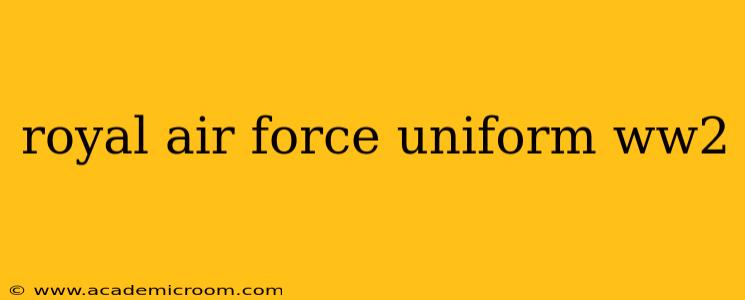The Royal Air Force (RAF) played a pivotal role in World War II, and its uniforms reflected the diverse roles and environments its personnel faced. Understanding the intricacies of RAF uniforms during this period offers a fascinating glimpse into the history and evolution of the service. This guide explores the various aspects of RAF WWII uniforms, answering many frequently asked questions.
What did RAF pilots wear in WWII?
RAF pilot uniforms varied depending on the role and the situation. For flying duties, the standard was a flying suit, typically made of leather or a durable, tough cotton. These suits were designed for protection and comfort in the cockpit, often featuring pockets for essential items and sometimes even incorporating fur-lined collars for warmth at high altitudes. Over this, pilots might wear a sheepskin-lined flying jacket, especially during colder missions. When not on flying duty, pilots generally wore the standard RAF officer's or airman's uniform, with variations in rank insignia and embellishments. The iconic leather flying helmet, goggles, and silk scarf completed the look, though the specific style and color could vary.
What were the different types of RAF uniforms in WWII?
The RAF utilized a range of uniforms to suit various roles and situations. These included:
- Flying Suits: As mentioned above, these were crucial for pilots, providing protection and mobility in the cockpit.
- Service Dress: This was the standard uniform for everyday wear, often involving a tunic, trousers or skirt, and a tie. The specific design elements varied with rank.
- No. 1 Dress: This was a more formal uniform used for ceremonial occasions.
- Battle Dress: A more practical and durable uniform designed for ground crew and other personnel working in less formal settings.
- Tropical Uniform: A lighter uniform adapted for service in hotter climates.
The materials used also varied, reflecting practicality and availability. Wool, cotton, and leather were commonly used, with variations depending on the specific garment and its purpose.
What were the RAF insignia and rank structures during WWII?
RAF insignia and rank structures were quite detailed. Rank was indicated through shoulder boards, sleeve stripes, and other markings on the uniform. Crown and wing insignia were commonly featured, signifying the air force. The specific placement and style of these insignia helped to quickly identify an airman's rank and role within the RAF. Specific insignia also indicated various specialist roles.
How did the RAF uniform change throughout WWII?
While the basic framework of the RAF uniform remained consistent throughout the war, there were some notable changes. These changes often reflected practical considerations, such as modifying materials due to wartime shortages or adapting designs to suit new operational needs in different theatres. There were also minor alterations in details, like the placement of pockets or buttons.
What are some common misconceptions about RAF WWII uniforms?
A common misconception is the uniformity of RAF uniforms. While there were standardized designs, variations existed based on rank, role, and even the specific unit a serviceman belonged to. Another misconception is that all pilots wore the same type of flying helmet or goggles. While many elements were standardized, subtle differences existed in these items as well. Finally, the idea that all uniforms were identical in every theatre is incorrect. Adaptations to suit climate and operational needs were common.
Where can I find more information on RAF WWII uniforms?
Many museums and archives hold significant collections of RAF uniforms and related artifacts from WWII. Books, journals, and online resources dedicated to military history and the RAF offer detailed information about the uniforms worn by its personnel during the conflict. These resources frequently include high-quality images to aid in identification and understanding. Exploring these options will offer a deeper appreciation of the nuances and significance of RAF attire during World War II.
This comprehensive overview provides a detailed understanding of RAF uniforms during WWII, addressing common questions and highlighting the diverse and crucial aspects of this subject. Remember that the RAF's role in the war was pivotal, and their uniforms reflect this history, serving as a significant part of their legacy.
